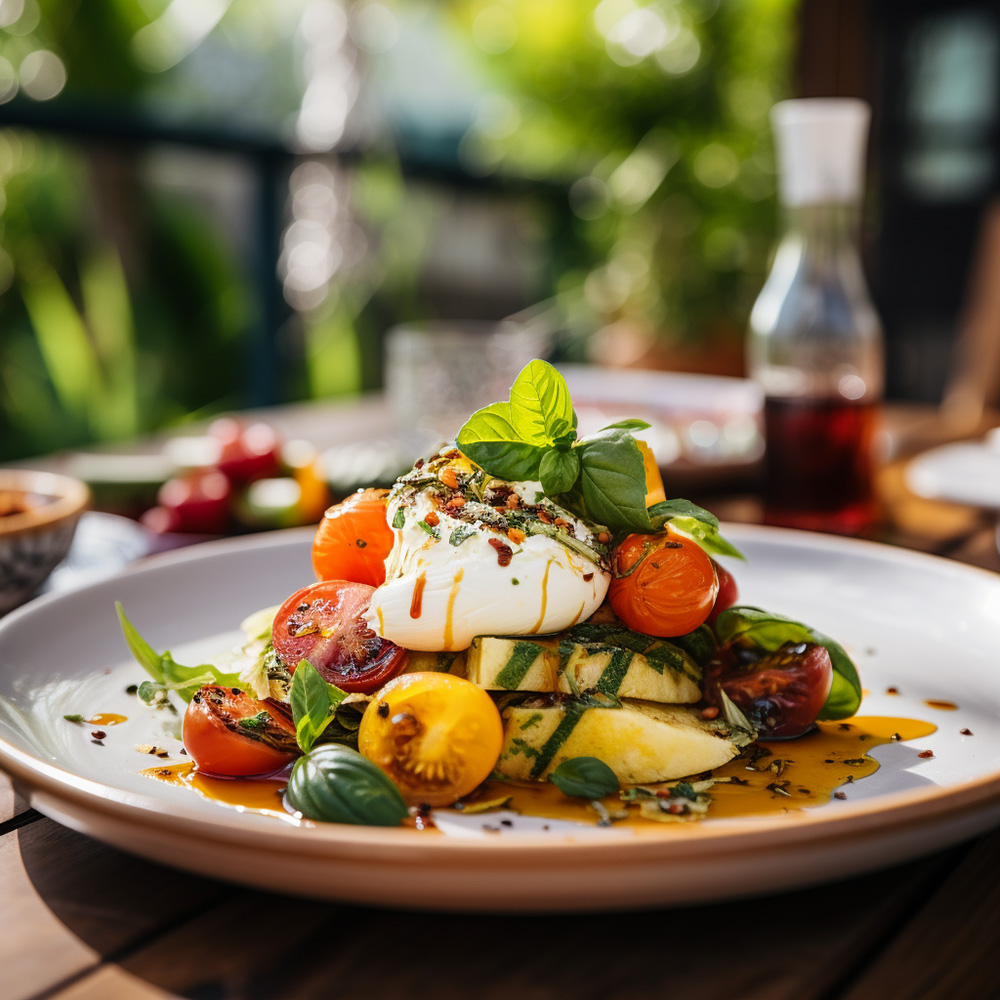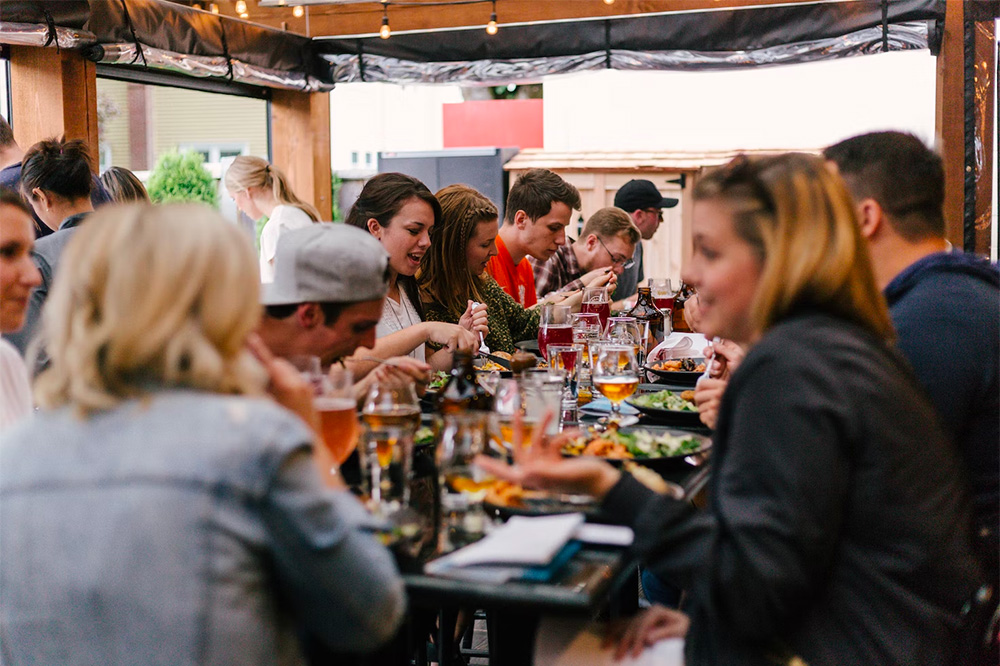
Hospitality Inventory Management Systems
Inventory or stock cost makes up 25% - 35% of your hospitality businesses costs as a percentage of revenue. It is almost certainly the largest expense in your bar, restaurant or cafe. It goes without saying that an easy-to-use, accurate hospitality inventory management system is key for managing your inventory properly and achieving a world-class cost of goods.

What is a Hospitality Inventory Management System?
A hospitality Inventory Management System, also known as restaurant inventory management software, is specifically designed to improve bar and restaurant operations and profitability. Inventory software allows food and beverage operators to track and monitor the most complex and expensive part of a hospitality business. Money is saved when stock is managed with more accuracy and easy to understand reporting then allows operators to focus on the areas of their stock management that need to be improved.
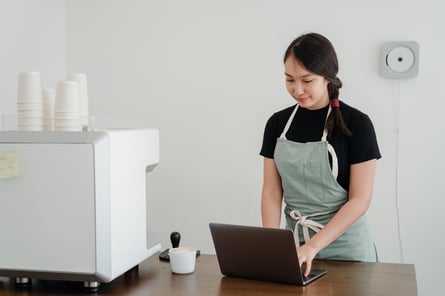
Inventory Software for Restaurant Management
To improve operational efficiency, restaurant owners use restaurant inventory management software to manage their stock or inventory from start to finish.
The benefits of restaurant inventory management software can be huge as internal processes are streamlined and more control is gained over food and beverage costs and profit margins.
Good inventory software can help you reduce food waste, analyse and manage menu costs, manage stock across multiple locations, and provide a seamless inventory management system between supplier and restaurant.
Inventory Software for Bar Management
For bar owners, inventory management software gives the ability to understand the exact cost of goods in real-time. Access to one fully integrated solution gives a quick re-order process and visibility over total inventory cost.
By integrating with the POS system, bar owners are provided with valuable insights into whether their current stock quantities are in line with their predicted sales for the upcoming day, week or month.
How was Restaurant Inventory Management Handled in the Past?
Historically, bar and restaurant managers have needed access to multiple platforms or spreadsheets to manage inventory. Unfortunately, this not only increased the amount of time they spent on administering stock management, but it also decreased the visibility and control they had on their entire end-to-end stock management process.
The Process before Fully Integrated Inventory Management Software:
- Order stock from suppliers in several different supplier portals.
- Receive stock manually into the point of sale system (POS system) to get the correct inwards goods.
- Have a separate piece of restaurant management software or error-prone spreadsheets to manage food costs and cost out recipes.
- Rely on archaic reports from the point of sale (pos) system to try and understand expected food and beverage margins.
All this work was required to understand what a restaurant, bar or cafe's margins were, when the kitchen and front of the house put all of their raw stock items together to serve finished menu items to customers.
To say it was impossible to do this properly is an understatement, and the time hospitality owners and managers invested in trying to manage inventory outweighed any potential gains they could get because the cost of goods data was almost always inaccurate and out of date.
How can Inventory Management be Simplified?
To take such a complicated area of hospitality and make it easier required the development of specialist hospitality inventory management software and platforms.
An inventory software solution was needed to simplify inventory management, where all of the ordering, recipe creation, margin analysis, contract pricing, stocktaking, and food and beverage wastage tracking could all be managed from one place.
It also required seamless integration with the point of sale POS and accounting software so that cost of goods could be tracked in real-time on every product being sold, and bar and restaurant owners could stop getting nasty surprises when they produced a profit and loss statement at the end of each month.
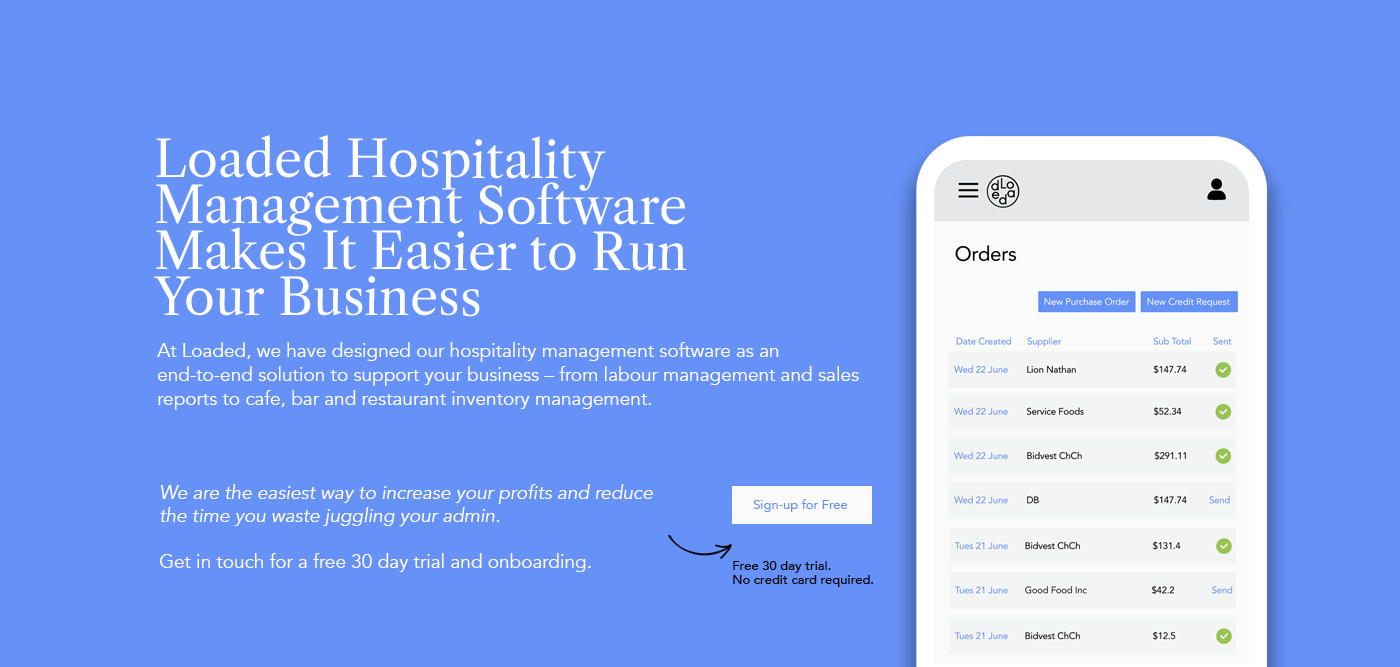
What is Considered Inventory in a Food & Beverage Service?
Inventory for the food and beverage industry includes all the physical items within the menu, including the ingredients of every meal and drink that is sold. Each ingredient and quantity used needs to be recorded accurately to ensure that good inventory management practices are maintained, and great margins and profitability can be achieved.
![Final Loaded Pillar Page | Hospitality Inventory Management Systems [3]-Nov-10-2022-04-18-03-9994-AM](https://assets-global.website-files.com/6531b2468ab95a04671ea5e5/65668a9bf77f63efe4097ced_Final%2520Loaded%2520Pillar%2520Page%2520%257C%2520Hospitality%2520Inventory%2520Management%2520Systems%2520%255B3%255D-Nov-10-2022-04-18-03-9994-AM.jpeg)
Food & Beverage Inventory Categories
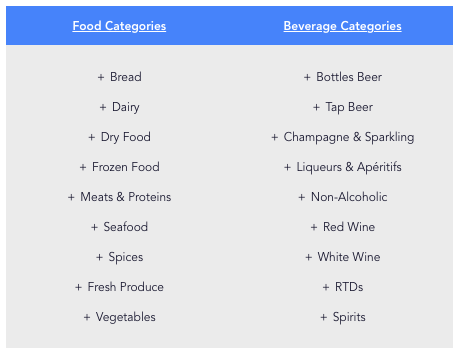
What are the Benefits of having Hospitality Inventory Management Software?
- On average, you will decrease your cost of goods by $80,000 for every $1 million of revenue you make when you fully implement an easy-to-use, entirely end-to-end inventory management software.
- Save time by ordering with all suppliers via one platform.
- Understand your overall food and beverage margins in real time so you can make rapid changes to affect profitability.
- Review menu's with all ingredients and sale prices already available before you release the menu.
- Test changes of portions or ingredients in recipes and instantly view the shift in your margin.
- Keep track of the effect discounting has on your overall margins and how this affects your profitability.
- Increase customer satisfaction by avoiding out of stocks.
- Because you always know how much stock you have on hand, ordering becomes much more rapid, and over-ordering is significantly reduced.
- Constantly track the value of the stock you have on hand, so you don't have too much of your cash flow tied up in inventory.
- Your admin and finance team works from the same platform as your on-site team, therefore as orders are made and received, you end up with daily and the weekly cost of goods data that matches the profit and loss statement you produce each month.
- Reduced wastage and shrinkage.
![Final Loaded Pillar Page | Hospitality Inventory Management Systems [3]-Nov-10-2022-04-18-05-9423-AM](https://assets-global.website-files.com/6531b2468ab95a04671ea5e5/65668a9d09562e862c5e83d5_Final%2520Loaded%2520Pillar%2520Page%2520%257C%2520Hospitality%2520Inventory%2520Management%2520Systems%2520%255B3%255D-Nov-10-2022-04-18-05-9423-AM.jpeg)
Front-of-House Operations Made Smoother
With a clear understanding of what is in stock, your front-of-house team can manage the customer's expectations right from the start of their experience with you. Giving all staff a clear picture of what food and drink are available will:
- Improve Customer Experience
- Improve Communication between the Front and Back of the House
Back-of-House Operations Made Smoother
Inventory management software is designed to improve back-of-house operations and provide an easier way of managing stock and margins.
Having simple and effective inventory management tools will:
Make Order Management Easy
- Optimise Inventory with Suggested Ordering
- Place Orders and Deliveries Easily
Know What Stock You Have with Real-Time Inventory Tracking
- Spot check - actual vs. expected stock levels
- Connect live sales to manage inventory levels
Reduce Costs and Manage Your Menu
- Menu analysis and management
- Recipe analysis and management
- Reduce food waste

Why is Inventory Management Software Important for Specific Hospitality Sectors?
A tech-based solution helps with reducing input costs, labour expenses and time taken with administrative tasks. Each segment within the hospitality industry can also benefit for their own unique reasons.
Below is a look at each type of business within the industry. Find your niche and see how it can help you.
Inventory Management Software for Franchises

Within a 5 year period, over 15,000 franchise units in New Zealand and Australia have closed their doors. This period has been particularly difficult as businesses could not function the same way due to lockdowns and staff shortages. However, many of our successful food service franchise businesses diversified and developed multi-channel sales pipelines including takeaway and delivery services. This prompted an upgrade in technology through the likes of UberEats which has been useful in maintaining sales revenue through a troublesome period.
The same can be said for our partners who have embraced inventory management software. By adopting an all-in-one inventory management system, Franchises now have a simple way to manage stock and get a clear overview of their whole operation from one centralised system. This has given them the power to make key high-level changes to increase profitability right across their franchise network.
Benefits of an Inventory Management System for Franchise Owners
- Purchase better because you know group stock volumes and usage and can negotiate better rates with suppliers.
- Provide more consistency to customers with consistent recipes right across your network.
- Produce menus systematically that can be priced for every franchise based on where they are in the country and the pricing they receive from suppliers.
Restaurant Inventory Management Software
It can be overwhelming for a head chef to consider creating accurately costed recipes for absolutely everything on the menu. The good news is that restaurant inventory management software allows you to implement systems to manage menu costs in a stepwise manner so you don’t have to do it all in one go.
With Loaded, you can easily see cost variations between your suppliers and have the reporting to support you when negotiating the cost of goods savings on your high-volume and high-value stock items. You'll be able to create a menu balanced not just on taste and popularity but also on profit.
It's not necessary to have every recipe in your restaurant 100% complete before you can monitor actual stock usage against what you expect to use and then make changes that increase profitability.
Where Should a Restaurant Start with Inventory Management?
- Ensure all items are ordered and received via your restaurant inventory management software.
- Have your top 10 selling items fully costed via recipes, as this is where the most risk lies for losing money through poor margins or wastage.
- For the rest of your menu items, start by pricing out the high-value stock items in the recipe. For example, focus on the protein portion of the meal.
- Start a weekly stocktake of the top 10 items you go through. The 80/20 rule applies, and these items are likely where a lot of the risk for losing money sits.
High-Risk Items in a Restaurant Almost Always Include:
- Proteins - particularly expensive cuts of meat portioned by the kitchen team.
- Perishable items are almost always over-ordered.
- High-volume items that are prepped before service by several different staff members during the week.
Good Inventory Management Starts with the Head Chef
The head chef doesn't have to do all the work in implementing an Inventory Management System, but implementation very rarely goes well if they are not all over the detail of the recipe setup and costings.
Over time they will be able to get other team members to get involved, particularly with stocktaking and ordering. Still, the head chef should be tasked with the responsibility of getting this setup initially.
The days when a head chef only creates and cooks a menu without accountability for profit and performance are long gone, and it should be the hospitality business's expectation that the kitchen manager or head chef can create a menu and be accountable for its contribution to the business's overall financial performance.
Bar Inventory Management Software
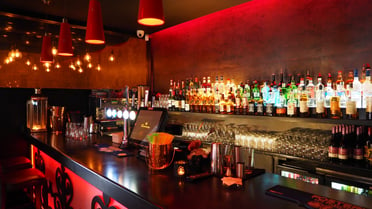
The good news for bar owners and managers is that there is significantly less complexity in managing beverage inventory than food inventory. Therefore, introducing a stock management system will see an almost instant boost to your beverage gross profit if you implement it in a stepwise manner.
The menu in your bar generally has significantly more stock items you buy from the supplier and sell to the customer without modifying them. For example, items like bottled beer or a bottle of champagne can be managed very easily with an Inventory Management System. It is very easy to track whether you are actually going through more of these than you are selling (known as wastage or shrinkage).
Where Should a Bar Start with Inventory Management Software?
- Make sure all items are ordered and received via your inventory management software.
- Have your top 50 selling stock items set up with the correct portion sizes so that you know the exact margin on these items.
- Start a weekly stocktake of high-risk items.
High-Risk Items in a Bar Almost Always Include:
- All keg beer.
- All house wine or wine that you sell a significant volume of by the glass.
- House spirits.
- Any expensive spirits that are free-poured as part of high-selling cocktails.
- Items you sell late at night, as this tends to be where staff make the most mistakes, such as RedBull and Vodka.
A Tip to Manage Margins
When most businesses analyse the margin on a beverage item they are selling in their bar, they do this at the full sale price. Almost every bar does some form of discount, whether for loyalty or club members, staff discounts or the owners not paying for drinks they have.
If you use the point of sale to track all discounts on any items sold (even if the owners are getting a 100% discount), this will help provide you with your average sale price. The average sale price is going to determine what your actual margin is. A good Inventory Management System will tell you how discounting affects your overall margins.
You can then decide whether the discounting you are doing is driving enough revenue to justify the overall effect it is having on your gross profit percentage. Appoint a Front-of-House stock manager and give them an extra 3 to 4 hours a week to complete stocktaking and track down variances or inconsistencies in how the stock has been set up in your Stock Management System. This can be someone other than your Front-of-House Manager or General Manager.
It's an excellent opportunity to give a more junior manager extra responsibility but ensure they are provided with the correct training from your team. It is worth investing in this as the reward will be 10x Greater when they start reducing your cost of goods.
Cafe Inventory Management Software
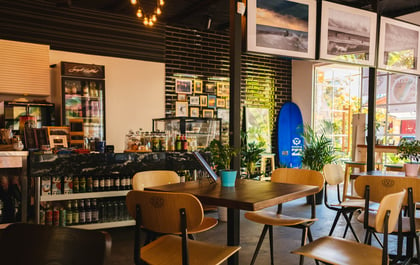
Most cafes will have an a-la-carte and a rotating pre-prepared counter menu. Because the counter food is often changing or maximising the use of perishable ingredients before expiry, there is a misconception that inventory management is too difficult for a cafe-style operation.
However, with 60 - 70% of sales in a cafe usually attributable to food, Inventory Management is a critical element of running a successful cafe.
Where Should a Cafe Start With Inventory Management Software?
- Make sure all items are ordered and received via inventory management software.
- Have the counter menu items that are sold every day set up as recipes and correctly costed based on the portions you sell these as.
- Have your top 10 selling 'a-la-carte' menu items correctly set up with recipes.
- Start a weekly stocktake of high-risk stock items.
High-Risk Items in a Cafe Almost Always Include:
- Proteins in your a-la-carte menu.
- Counter items made in large quantities that must be used in a single day's trading.
- Coffee beans.
- Milk.
End-to-End Stock Control & Inventory Management in Real-Time
Loaded brings you the joy of true end-to-end stock management to ensure real-time cost of goods accuracy.
Our hospitality automation solution was designed by hospitality professionals for hospitality professionals. Get a clear picture of what's happening within your business and inventory management without the mess and stress.
Connect Loaded to your existing Point Of Sale System and take back control of your food costs, stock management and business expenses.
Start your free 14-day trial today! Sign up for loaded, and experience the benefits for yourself.
What can go Wrong Without Effective Inventory Management?
Without effective inventory management, you and your team will turn up to work and work hard every day to give your customers a great experience, but because you don't have control of the financial performance of your inventory, your business will never produce stable profitability.
It means you have to work harder and harder and continually bring in more and more customers if you want your business performance to improve. This puts significant stress and workload onto the owners and managers of the business, which over time leads to a reduction in creativity and inspiration throughout the culture of the company, which your customers eventually feel in terms of the experience they have.
Work Smarter, Not Harder
Think of implementing inventory management as your ability to make more money by doing the same amount of work or the ability to increase profitability without having to increase the number of customers you get through the doors. People often talk about working smarter, not harder, and implementing good Inventory and Stock management is this in action.
When we implemented an Inventory Management System and started focusing the team on the problem items within our business, our margins and our profitability just got better and better. - Liz Perkins, Former Restaurant Owner & Now Leading Hospitality Coach
How to Pick the Right Restaurant Inventory Management System for Your Business
The Inventory Management System you choose for your business must be the right fit for your business type and your ambitions. For example, if you own a 300-site franchise business specialising in fast food, you'll need a very different system from a single fine dining restaurant. When you assess the Inventory management software website or meet with the vendor with these questions, be confident you pick the right partner.
- What other businesses like yours do they currently work with?
- Are your team who have to use it going to find it intuitive and easy to use?
- How will they train and support you?
- Can you implement in a stepwise way getting progressively more value the more you implement?
- Can they clearly tell you where your cost of goods savings will come from using their system?
- Does it integrate with your point of sale and accounting software?
- Can you see if their system will be able to grow as your business grows?
- Are they going to be around in five years' time?
What Should Your Inventory Management Software be able to do?
Picking the right inventory software is critical as it requires some effort in onboarding and training your team to use it. From Restaurant Owners to General Managers, Loaded Software includes specific hospitality management tools to help your business grow and make your life easier!
Here is a list of what is important depending on your business type.
If You Run a Hospitality Group
Your Inventory management software should be able to scale as your business grows. For example, give your bar and restaurant managers a simple, all-in-one solution to manage food costs, waste, and labour costs. For the GMs and Ops Managers, the right inventory management software can streamline your whole operation.
Here is a list of what you should be looking for:
- View all products sold and stock purchased by quantity and value across your group.
- Manage tenders and contract management across your group.
- Synchronise purchase prices on stock items across your group, but also allow individual prices where relevant.
- Benchmark your cost of goods performance across your group of sites.
- Share and manage everyday stock items and recipes right across your group.
If You Run a Single Hospitality Site
If you have a bar, cafe, or restaurant, inventory management software should be like your right-hand man, allowing you to reduce time and effort controlling your stock and sales. Getting the right software can mean the difference between only surviving or growing your business and profitability.
Inventory software should include the following:
Order Control
- Create one order that can be sent directly to all of your suppliers.
- You should be able to monitor your agreed prices with suppliers against what they actually charge you.
- Create order templates so you can complete orders fast and accurately to reduce over-ordering.
Stock Control
- Tell you how much stock you have on hand at any single point in time.
- Create credit notes when stock is returned.
Cost Control
- You should be able to analyse the cost of goods of every product you sell in real-time.
- As you receive your stock, the prices of your recipes and your margins on recipes should update automatically.
- Link with your accounting system so your inwards goods are always accurate and your profit and loss reports don't give you nasty surprises each month.
- Allow you to review the gross profit margin on an entire menu before you launch it.
Stocktaking
- Allow you to stocktake on as many or few items as you like so that you can focus on problem items but also have total stock valuations and know the variance on every item you sell.
- Allow you to stocktake any bulk recipes that you make.
The Full 360 Package - Ideally, your Inventory Management Software should also include labour management tools like scheduling and digital timesheets, so you also know your labour cost and overall gross profit.
Hospitality & Restaurant Inventory Management Best Practices
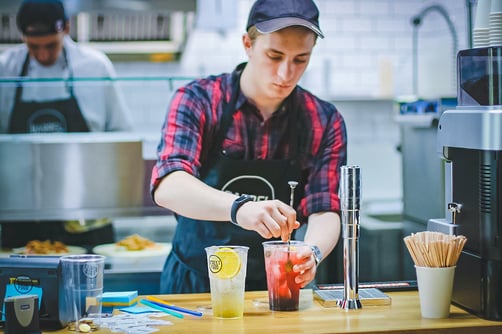
To be running the tightest cost of goods possible, you want to aim to be operating as per best practices. However there are plenty of steps you can take along the way to get there, and it's important you implement at the right pace for your team and your business.
- Order inventory based on the current stock on hand and what you expect to sell for the upcoming day or week.
- Have your team receive orders into your restaurant inventory management software daily to ensure pricing and stock on hand are constantly up to date (a small labour investment in getting this right will pay the considerable cost of goods dividends down the track).
- Have your admin team export the receipted purchase orders to your accounting system so that your inward goods are always the same between your inventory management Software and your accounts.
- Complete a full weekly food and beverage stocktake.
- Complete a daily stocktake on 3 - 5 beverages and 3 - 5 food items you have been having problems with waste or shrinkage.
- Tender all the beverage items and approximately 60% of the food items you purchase with at least three suppliers to ensure you always pay the best prices in the market.
- Incentivise your head chef and your restaurant manager or general manager on achieving an agreed cost of goods percentage each week. 0.5% of weekly revenue shared amongst the managers is a good place to start.
How to Get Accurate Cost of Goods with Inventory Management Software
Calculating food costs and menu costing can be time-consuming and inaccurate if you are working it out on a spreadsheet. You often pull information from different sources like supplier invoices and your POS system.
The Profit You Make and Your Cost of Goods
Imagine your business sells one product and one product only.
This one product happens to be a very simple beef burger that sells for $10 EXC GST. The buns in the burgers cost you $1.50 EXC GST, and the meat patties also cost you $1.50 EXC GST.
This means you have a cost price of $3 and a selling price of $10. So if we divide our cost price of $3 by our sell price of $10, we end up with a 30% cost of goods.
Now, if we sell 5,000 of these burgers every week, we will have sales of $50,000 (5,000 quantity sold X $10 sell price) and a cost of goods of $15,000, which leaves us with a gross profit of $35,000.
Now, of course, you operate your hospitality business in the real world where “stuff” happens and this "stuff" is going to reduce your Gross Profit if you don't monitor and manage it like a hawk.
What is the Difference Between Wastage and Shrinkage: Why is it Important?
We can break that “stuff” into wastage, shrinkage and discounting. Below are the common contributors to each of these categories that increase your cost of goods and reduce your margins.
Wastage Examples

- Damaged Stock: If one of your team burns a burger bun or overcooks a beef pattie, you still have the cost of the bun and the pattie but no revenue for those two items, so your actual cost of goods is now higher than what you initially calculated.
- Over-Ordering: The person responsible for ordering didn't look very carefully at the amount of stock they had or the sales you usually make before they made an order, and they ordered way too many burger buns. By the end of the week, seven bags of 12 burger buns had mould on them. This is the same issue as above, just on a much larger scale.
Shrinkage Examples
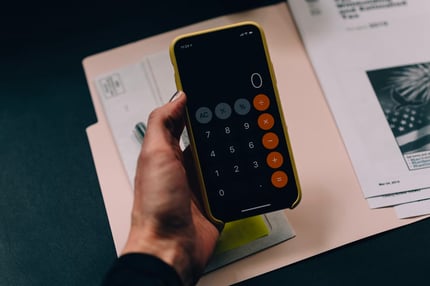
- Poor Portion Control: You had a new team member start, and because he didn't get any training, he ended up thinking that you are meant to put 2x patties in every burger. So suddenly, every burger you are selling has $3 worth of patties instead of $1.50, but you are still only selling each burger for $10. Whoops, your cost of goods just went up.
- Theft: You start opening your burger shop late at night and have a young manager in charge. Their friends end up coming in and putting pressure on them to give them a free burger on their way home. This is more dishonest than the first shrinkage example, but the effect is the same, as your cost of goods has gone up.
Discount Examples

- Customer Discounts: When you planned your burger sale price at $10, you didn't make any allowance for the fact that you have a loyalty club, and people with a loyalty card only pay $8 for their burgers. So of the 5,000 burgers, you sell 1,000 at $8, which means that your revenue is now only $48,000, but your cost is still $15,000, which means your goods for the week have increased to 31.25%. Ouch!
- Team Discounts: Your hardworking staff are allowed a free burger when they work more than 8 hours, and this happened 25 times last week. That's effectively 25 burgers that were sold at a 100% discount, and you guessed it, this makes your actual cost of goods higher than what you calculated them to be when you started your business.
Inventory Management Software can Help You Monitor Your Losses
In every hospitality business, there will be a combination of wastage, shrinkage and discounting that will mean your actual cost of goods is higher than what you calculate it should be. A good Inventory Management System gives you the monitoring and reports to understand this and the tools to dive in and fix these problems so that your margins and your profitability increase.
Ideally, you will be making a lot more money each week without selling any more beef burgers.

More Profit
Making money doesn’t happen by accident! Learn how to tune your business and improve your bottom-line.

More Success Stories
Get inspired by stories from real Loaded customers who run thriving hospitality businesses.
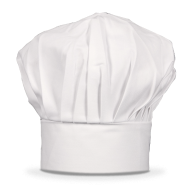
More Labour
Get tips for optimising your staff’s time, and for managing your team effectively.

More Culture
Making money doesn’t happen by accident! Learn how to tune your business and improve your bottom-line.

More Design
Making money doesn’t happen by accident! Learn how to tune your business and improve your bottom-line.

More Design
Making money doesn’t happen by accident! Learn how to tune your business and improve your bottom-line.

More Design
Making money doesn’t happen by accident! Learn how to tune your business and improve your bottom-line.
Learn from the best
Find articles, videos, E-books and more all delivered by our qualified, world-class community of expert hospitality operators: take a look
Season 2: Spring Bootcamp for a Money-Making Summer
We've poured our 100+ combined years of hospitality experience into a series of live and recorded webinars that will be your bootcamp for a money-making summer.



